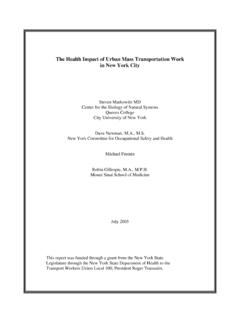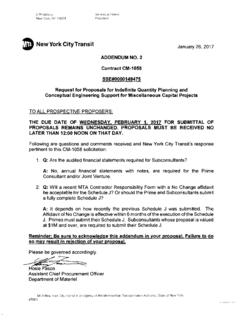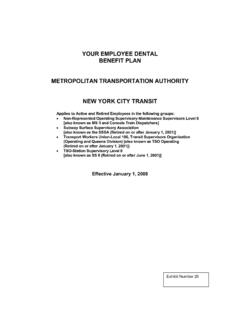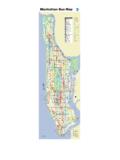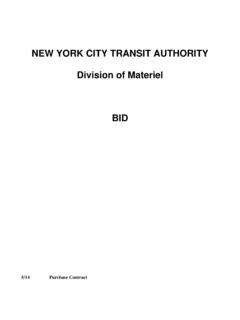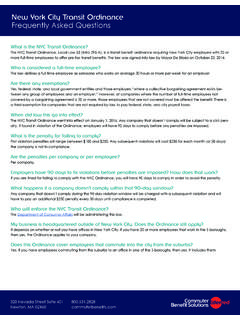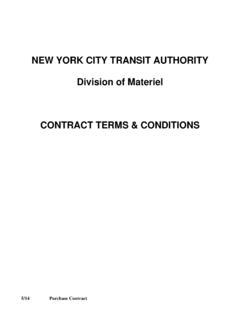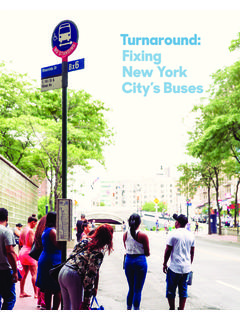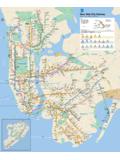Transcription of Analysis of Alternative Fuel Technologies for New York ...
1 new york city transit Riders CouncilAnalysis of Alternative FuelTechnologies for new york CityTransit BusesFebruary 2000 Jonathan SigallAssociate DirectorNew york city transit Riders Council 347 Madison Avenue, new york , NY 10017(212) 878-7087 preparing this report, the author received assistance from numerouspeople. Some graciously spent a significant amount of time discussing the issueand provided many of the documents that form the basis for the research. Othersprovided valuable editorial assistance that helped shape the final who assisted in the research of the report are Brian Ketcham ofKonheim and Ketcham; from new york city transit , Dana Lowell, Bill Parsley,Donald Tsang, and Millard Seay; Larry Penner of the Federal TransitAdministration; Jai Theratil of the new york city Department of Transportation;Ken Newkirk of the new york State Department of Environmental Conservation;James Pachan of the Los Angeles County Metropolitan Transportation Authority;Steve Weber of the Regional Plan Association; Joseph Rappaport of the Office ofNew york city Public Advocate Mark Green.
2 And Robert Paaswell of theUniversity Transportation Research Center - Region assistance was provided by the members and staff of the NewYork city transit Riders Council. The author is especially appreciative toExecutive Director Beverly Dolinsky, Transportation Planner Michael Doyle,former Research Associate Sarah Massey, Chairman Andrew Albert, andmembers Stephen Dobrow, William Guild, and Stephen Wilder, each of whomreviewed the report and offered many helpful editorial Assistant Mary Whaley provided production of ContentsExecutive Summary_____iIntroduction_____1 Analysis of Issues_____3 Types of Emissions_____3 Particulate Matter_____3 Nitrogen Oxide_____4 Hydrocarbon_____4 Carbon Oxides_____5 Emission Characteristics of Natural Gas and Diesel Fuel_____5 Natural Gas_____5 Diesel Fuel_____7 Vehicle and fuel Technologies_____8 Natural Gas Buses_____8 Hybrid Electric Buses_____13 fuel Cell Buses_____16 Low-Sulfur fuel and Exhaust-Treatment Systems_____17 Conclusions.
3 Analysis of NYCT's Bus Program_____22 Recommendations_____28 Bibliography_____30 The new york city transit Riders Council was created by the new york State Legislature in1981 to represent the interests of bus and subway riders. The fifteen volunteer members are usersof the transit system and are appointed by the Governor, upon the recommendation of the Mayor(five members), the Public Advocate (five members), and the Borough Presidents (one membereach). For more information on the Council, please visit our website: of TablesTable 1: EPA Emissions Standards for Diesel Transit_____5 Bus EnginesTable 2: Comparison of Emissions from CNG and Standard_____8 Diesel EnginesTable 3: Comparison of Emissions from CNG and Hybrid_____15 Diesel-Electric BusesTable 4: Emissions Results with CNG and Alternative_____21 Diesel ConfigurationsTable 5: Incremental Bus Costs for All CNG Buses in_____252000-2004 NYCT Capital ProgramTable 6.
4 Incremental Depot Costs for All CNG Buses in_____262000-2004 NYCT Capital ProgramExecutive SummaryThe release of new york city transit 's (NYCT) 2000-2004 CapitalProgram in September 1999 renewed the debate on the appropriateness ofrelying on diesel buses to serve the city 's bus riders. The agency proposes topurchase 1,056 new buses, of which 756 will be articulated and express busesthat use diesel fuel . The remainder will be some mix of compressed natural gas(CNG) and hybrid diesel-electric buses. Some environmental advocates,including community groups and elected officials, strongly disagree with thisapproach. They feel that buying CNG buses is critical to efforts aimed at cleaningNew york city 's air in downstate new york contains dangerously high levels ofparticulate matter and ozone, two air pollutants that have been associated with arange of illnesses.
5 Exhaust from diesel trucks and buses contributes to theseunhealthy conditions. Diesel engines emit high levels of particulate matter,ozone-producing chemicals, and toxic compounds. Some of these exhaustcomponents are known carcinogens, and several health organizations haveproposed that diesel exhaust be classified as a cancer-causing of natural gas engines feel that this technology is the best wayto address these concerns. Natural gas burns more cleanly than diesel fuel andemits lower levels of particulate matter, toxins, and nitrogen oxide, whichcontributes to ozone formation. The technology has been proven in operationand is being used by several large transit properties such as the LosAngeles County MTA and the new york city Department of the many positive characteristics of natural gas, the issue is notthat straightforward.
6 Natural gas engines are not as clean as their proponentsassert. A recent study by the Harvard Center for Risk Analysis notes that naturalgas vehicles may emit a greater number of ultrafine particles than dieselvehicles. The new york State Department of Environmental Conservationreached a similar conclusion in tests it ran in the Spring of 1999. Researchshows that these smaller particles may be the most significant threat to humanhealth. Natural gas engines also appear to emit high levels of formaldehyde,which is a carcinogen, and are worse than diesel engines for the production ofgreenhouse gases. The primary component of natural gas is methane, which hasabout twenty times the global warming potential of carbon Alternative Technologies have demonstrated the ability to equal orbetter the emissions-reduction performance of natural gas.
7 In several tests, forexample, hybrid diesel-electric buses have done as well as natural gas buses forkey pollutants. Emissions of particulate matter in one test were grams permile for a hybrid bus, compared to grams per mile for a bus using diesel fuel containing low levels of sulfur was used, the results were evenbetter. Almost no particulate matter was released. Hybrid buses using standardiidiesel fuel have performed comparably to the natural gas buses on nitrogenoxide emissions and better on carbon monoxide emissions. Exhaust-treatmentsystems are emerging that could also lower diesel pollutants to the same levelsas natural gas pollutants.
8 The Environmental Protection Agency (EPA)anticipates that these advances will produce the same dramatic results ascatalytic Technologies did for gasoline emissions tests would be helpful. Questions need to be answeredon how each of the various Technologies compares regarding particle size anddistribution and emissions of toxins. Environmental advocates haveacknowledged that tests should be done both for hybrid and natural gas this year, NYCT plans a series of tests that should provide the more is known, NYCT should not be required to commit fully to CNGbuses. Converting to this technology poses several obstacles. Bus depotsrequire extensive modifications to make them safe for natural gas fueling.
9 Unlikediesel fuel , natural gas is lighter than air and will rise if there is a leak. The vaporswill ignite explosively if they come into contact with an open flame or spark. In themost realistic scenario, NYCT would need until at least 2006 to convert thedepots necessary to accommodate an all-CNG approach in the 2000-2004capital plan. The agency would have to defer a substantial amount of its buspurchases while it is readying the depots. Considering the explosive growth inbus ridership since 1996, NYCT needs buses now and cannot wait several yearsto expand its is a consideration. NYCT would need to spend hundreds of millionsof dollars to convert its depots and to replace the bus capacity that would be lostunder an all-CNG plan.
10 Annual operating and maintenance expenses appear tobe higher for CNG buses than they are for diesel buses. Other agencies haveencountered similar issues and have cancelled their CNG programs as a , natural gas is only an interim measure. fuel cell buses, whichgenerate power through the reaction of hydrogen with oxygen, have beensuccessfully demonstrated in transit applications. This technology could provideemissions-free vehicles and may be commercially viable within only a few would be imprudent to invest substantial resources in a short-termtechnology that may be no better than other alternatives . It is using both CNGbuses and hybrid buses, is experimenting with low-sulfur diesel fuel andparticulate filters, and has approached a manufacturer about conducting a fuelcell demonstration project.


